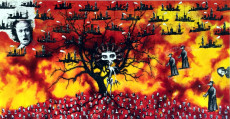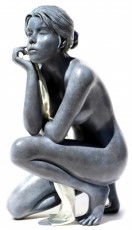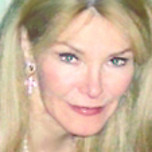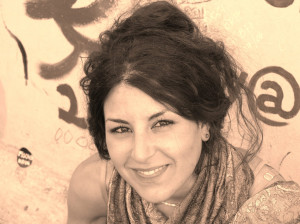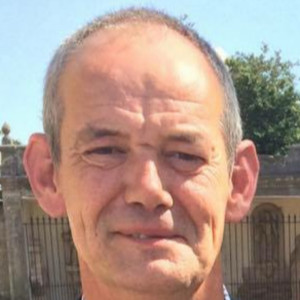
Alice Neel's painting photographs humanity

About the "Alice Neel" exhibition at the Centre Pompidou until 16 January 2023.
At last, Alice Neel (1900-1984) is installed at the Centre Pompidou. Everything conspired to keep this American painter, as figurative as she was political, in the shadow of the interwar period and of abstract expressionism, until the health crisis at Covid delayed the French retrospective devoted to her by the Musée national d'art moderne de Paris by two years. But this time it's here. One of the major figures of North American art has the floor. Only Georgia O'Keeffe (1887-1986) had managed to emerge from this generational omerta before her. And one suspects that the erotic aura of the modernist painter's paintings contributed to the desire of the gentlemen who were then making the art market alone to make her known. But with her characters from the bottom of the social ladder, whose naked truth on her canvases cries out to the world about the injustice of the class struggle and the inequality of the sexes, with her female nudes that are far removed from the traditional canon shaped by the male gaze, Alice Neel also has things to say!
Yes, "in these troubled times when the lives of others, of people of colour, minorities and immigrants, seem to matter less, Alice Neel has something to say", says Angela Lampe, curator of the modern collections of the Musée national d'art moderne, who conceived and kept the "Alice Neel. A committed look", despite all the storms that have shaken it. Just after the artist's long-obscured work was a huge success in New York at the Metropolitan Museum of Art from March to August 2021, the travelling exhibition was seen at the Guggenheim Museum in Bilbao, Spain, by Richard Leydier. The editor of Artpress therefore reports on it in the October issue of the contemporary art magazine, and his reflections shed a wonderful light on what makes Alice Neel's artworks so different from, say, those of the painters Alex Katz, born in 1927 in New York, and Philip Pearlstein, born in 1924 in Pittsburgh.
The latter two are undoubtedly the most brilliant representatives of the American artistic movement of the 1960s that has been called "New Realism", and which could be placed in the wake of Alice Neel, taking care not to confuse it with the French Nouveau Réalisme. Of course, Pearlstein is particularly known for his modernist realism nudes. Like Katz, he was close to Pop Art, Andy Wharhol and the abstract expressionist artists Pollock and Rothko. But for Ricahrd Leydier, the obvious is clear: "Pearlstein paints self-portraits with bodies when Neel paints portraits of people - indeed, his Spanish-American retrospective is entitled People Come First.
In her flat in New York's Spanish Harlem, where she lived and worked for most of her life, the communist painter and single mother on welfare always saw art as one of the ways to improve society, and never stopped depicting the marginalized people around her. Those who were shunned because of their origins, the colour of their skin, their eccentricity, their sexual orientation or the radicalism of their political commitment. She was not likely to care about surfing the contemporary art of her time, nor was she interested in conceptual art or minimalist art!
Alice Neel's works of art for sale, which at the time unfortunately did not sell enough to put her out of her misery, depicted people, people and more people. Even when she painted gloomy urban views for the Work Projects Administration (WPA) during the Great Depression of the 1930s, when Philip Guston (1913-1980) and many other painters were inspired by Mexican mural paintings, they were "strewn with skeletal creatures reminiscent of James Ensor's carnivalesque figures," writes Richard Leydier. And although her relative fame from the 1960s onwards enabled the artist to broaden the spectrum of her models to include more privileged circles, she always remained faithful to her communist convictions. A few weeks before her death, she said: "In politics as in life, I have always loved the losers, the outsiders. I didn't like the smell of success.
Alice Neel can't fool herself. Born poor in Pennsylvania, she knows the "real world". She was already over twenty when she began studying at the Philadelphia School of Design for Women, after working as a secretary. And when she married the Cuban painter Carlos Enriquez Gomez, she was not out of the woods yet. For a time, she frequented the artistic avant-garde in Havana and even held a few exhibitions while they were living there. But the fatal illness of her first daughter in infancy would not cease to haunt her painting. The couple moved to New York after the tragedy in 1926. And a second daughter was born in 1928... whom her husband took with him to Cuba when he left his wife two years later. Depression, attempted suicide, psychiatric hospital in Philadelphia. When Alice Neel returned to New York in 1931, she could not imagine that she would still have two sons to bring up alone, that she would sometimes have to shoplift to feed them, that she would act in a beatnik film with Allen Ginsberg, that she would one day portray Andy Warhol... but she knew that she was committed to women. And that she will always militate in the ranks of the Communist Party for the benefit of the most disadvantaged.
A great admirer of Balzac, Alice Neel is, to use Charles Baudelaire's expression, a "painter of modern life". As were Edouard Manet, Paul Cézanne, whom she also greatly admired, Vincent Van Gogh, or the great expressionists Oskar Kokoschka, George Grosz or Otto Dix. So what does it matter if today the spotlight is shining, for reasons that are sometimes somewhat reductive and linked to the contemporary era, on the work of a woman who was largely ignored for most of her life, and modestly recognised in the last quarter of her life. At least Alice Neel's artworks are now in the public eye.
"My idea is that Alice Neel was ultimately much more of a photographer than a painter," writes Richard Leydier in Artpress. "She does photography in painting when others do painting in photography."



















